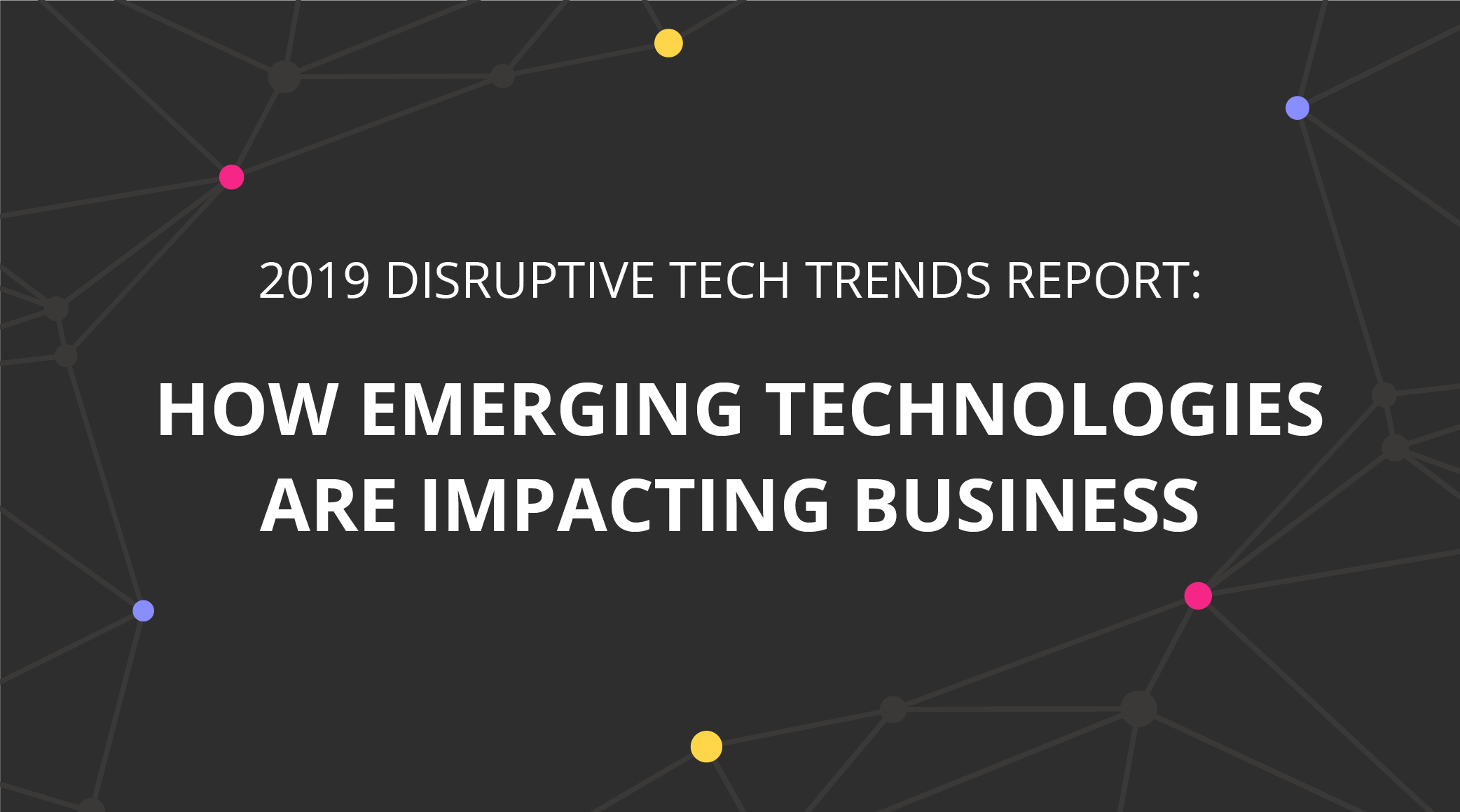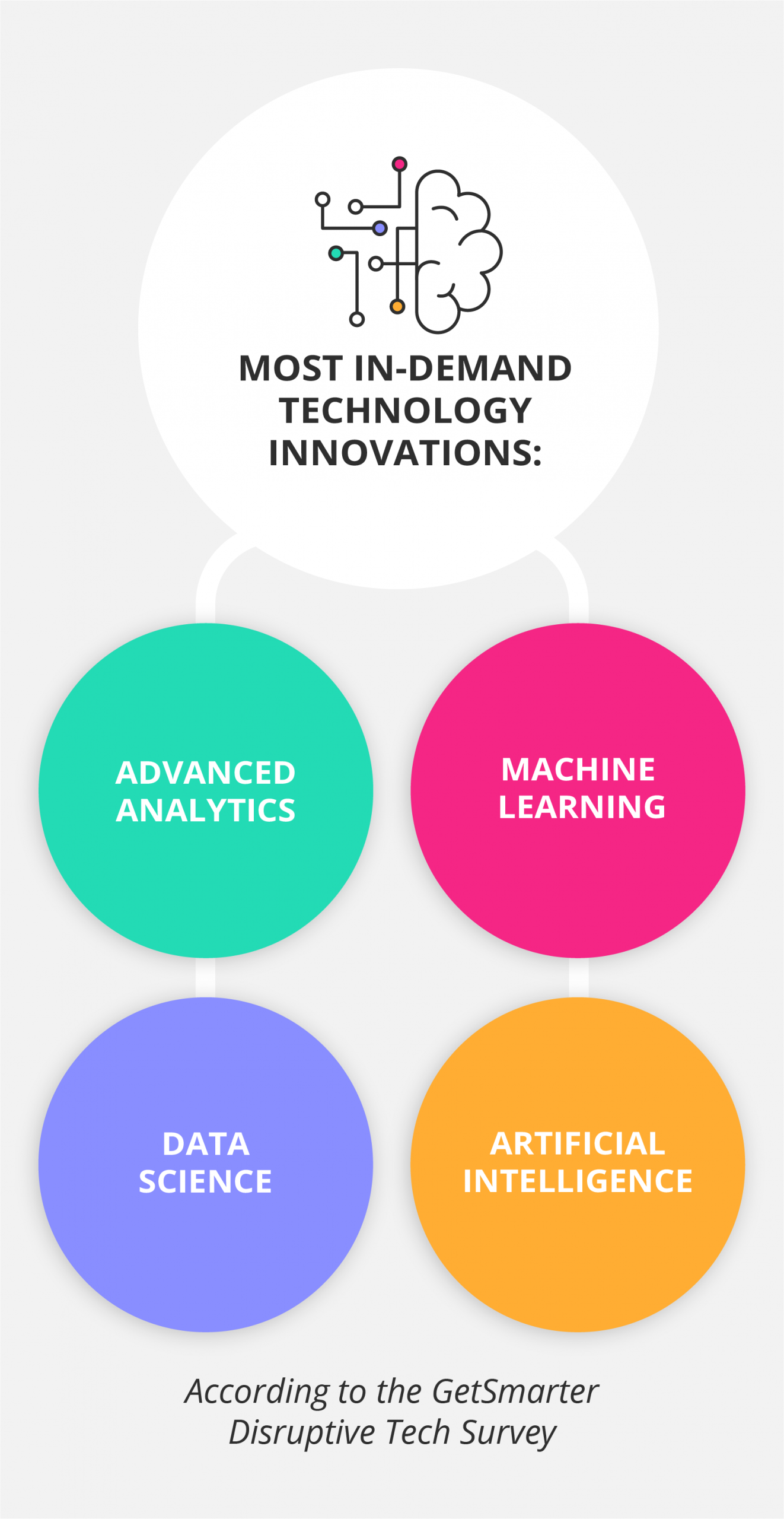2019 Disruptive Tech Trends Report: How Emerging Technologies Are Impacting Business

The biggest challenge in driving adoption of disruptive technology no longer relates to the technology itself. Business leaders seeking larger value gains from artificial intelligence (AI), for example, are increasingly faced with gaps in their organisational behaviour. A stronger focus on change management, workflow design, and employee upskilling is needed, along with a culture that promotes the use of data science and analytics.
This trend is observed in GetSmarter’s 2019 Disruptive Tech Survey, based on responses from 350 senior business professionals who have completed one or more of GetSmarter’s disruptive technology short courses. Most business leaders agree that emerging technologies can deliver great benefits, but to succeed at digital transformation requires a strategy centred not on technology, but on the people and processes impacted by it.
AI, the leading disruptive technology
One of the aims of the GetSmarter Disruptive Tech Survey is to determine which technologies or disruptive innovations are of most interest to business professionals. Consistent with last year’s results, AI topped the list of in-demand technologies for 2019.
This result could be expected, as AI is considered by many to be the most prevalent disruptive technology today.1 Numerous studies have reported on the value gains that pioneering firms have derived from AI, in the form of both cost-saving activities and new revenue-generating activities.2 Some manufacturers, for example, use advanced analytics to pinpoint redundancies in their processes, thereby saving on production costs.3 Other firms have created entirely new revenue streams from AI: Deutsche Bank in Germany built a consumer credit product that uses AI to decide whether to offer a loan to a customer, and within eight months of launching the product, their loan issuance rate increased 10- to 15-fold.4
Following AI, the other leading technology innovations that the survey respondents are most interested in include: machine learning, data science and, advanced analytics.

These fields or disciplines, while unique in many respects, are all linked to AI. Through combining statistics, mathematics, and computer programming, they ultimately serve a common purpose: to address business problems by understanding past trends and predicting future patterns. And while many businesses have invested in AI, acquiring the technology is really only the first step towards a successful data-driven strategy. To truly generate business value through AI requires so much more.
Winning with AI requires a focus on organisational behaviours
In a recent MIT study, 90 per cent of companies surveyed said they had made at least some investment in AI, though fewer than two out of five reported obtaining any business gains from AI in the past three years.5
In light of such slow progress, the popular sentiment around AI is changing. A number of industry commentators have recently observed that the positive hype surrounding AI’s potential has begun to give way to a sense of the great difficulty involved in scaling AI initiatives.6
A comparison of GetSmarter’s 2018 and 2019 survey results reveals that companies looking to drive adoption of disruptive technology, such as AI, are needing to shift their priorities beyond the technology.
In 2018, we asked respondents where they felt the most pressure from disruptive tech. The most-cited answer (at 25.4 per cent) was ‘product innovation’, which is a common approach for businesses starting out with an emerging technology.7 A recent Harvard Business Review (HBR) study observes that many businesses followed this approach in 2018, in response to the growing hype around AI, by acquiring the necessary hardware, software, and talent to get an AI pilot project off the ground. But the HBR study notes that real AI capability building requires much more than just ‘plug-and-play’ solutions.8 It requires efforts to overcome cultural resistance to automation, redesign workflows, improve workforce training, and enhance communication between teams – essentially, a change in organisational behaviours.9
The 2019 survey reflects these shifting priorities. While ‘product innovation’ was the most-cited strategy in 2018, that figure dropped by more than half to 12.4 per cent in 2019. The priorities highlighted by the 2019 respondents are less tech-oriented. Instead, they relate to the changes in organisational behaviour that the HBR study observes is needed to succeed with AI:

Business leaders need to carefully consider the different options available to them for dealing with each of these priorities. To combat skills shortages, for example, global research firm Gartner recommends investing in training for current employees rather than hiring outside talent, given the relatively low supply of advanced analytics skills in today’s labour market.10
While upskilling the broader workforce is important, equally vital is deciding who should steer AI initiatives.11 When companies rely on traditional IT executives, like the chief technology officer, their approach to AI tends to be restricted to current operating procedures. But successful AI adoption requires fresh and innovative ways of thinking, which is more likely to occur under the purview of a new executive, such as a chief digital officer or chief analytics officer.
Alongside the right C-level appointment, a successful AI strategy requires that leaders across the company have a firm grasp of the opportunity that AI presents, as well as a high-level understanding of how the technology works.12 Being knowledgeable on the subject also enables senior-level individuals to lead by example which, for staff members, helps to inspire confidence in the leadership layer.
Change management is another key ingredient for AI success. To drive adoption of AI, leaders need to anticipate potential social resistance and take active steps to counter it. Getting people onboard with AI requires more than simply telling them about the benefits of a particular AI-powered solution.13 Instead, business leaders should strive to create genuine excitement about the possibilities of AI by encouraging activities centred around not only producing AI, but consuming it. For example, teams could be invited to test out each other’s tools, participate in hackathons, or take part in creative feedback sessions.
If leaders think about AI like a balance sheet, then they’re missing the point. You need to get emotional attachment to the disruptive nature that it can bring.14
Werner Boeing, CIO at Roche Diagnostics
Data and technology no longer an IT-only priority
An important factor driving the shift in digital strategy from being mostly tech-centric to including people and process, is the increasing reach of data into different corners of a business. Years ago, when the age of big data was still considered a novelty, most activities involving tech systems or number-crunching were considered part of the exclusive domain of IT.15 Since then, analytics has become a powerful source of value across business teams.
The GetSmarter survey asked respondents which of their departments are being impacted the most by disruptive technology, and the results reveal the same trend:
- From 2018 to 2019, there was a sixfold increase in the number of respondents who said their most impacted team is human resources (HR) or talent management. This is consistent with the rise of people analytics, an emerging practice centred on the use of data in HR teams to monitor organisational health and personalise the employee experience16
- Compared to 2018, a larger share of 2019 respondents cited marketing and communications, project or program management, and design and creative as being the most affected
- The number of respondents who indicated IT dropped from 30.1 per cent in 2018 to 16.4 per cent in 2019, indicating that the role of data and technology is no longer limited to IT teams
Practically any department in a business today can tap into the treasure trove that is analytics. But achieving this requires new forms of cross-functional collaboration. For example, technical professionals like data scientists, data analysts, and data engineers are more frequently needing to partner with line-of-business analysts or functional managers in order to help them understand the data that is relevant for decisions related to product deployment or other internal business problems.17 This desired ‘cross-pollination’ requires the right mix of skills: technical professionals need to have strong communication and be interpersonally savvy, while non-technical analysts and managers need to ensure they understand the basics of data interpretation.18
If business leaders want to succeed at integrating technology across different functions, part of upskilling teams is to reassess existing processes and helping employees manage the required changes.
Leveraging disruption demands more than technology
Digital disruption presents a myriad of opportunities for businesses that want to tap into this space. The GetSmarter 2019 Disruptive Tech Survey highlights that to make real gains through disruption, acquiring the right technology is necessary, but not enough.
When deciding on a strategy for disruption, business leaders need to consider technology, as well as the skills development and process changes necessary to put it to use. But perhaps most importantly, leaders need to find creative ways of socialising the use of these technologies in order to make them a routine component of every staff member’s toolkit.
- 1 (Mar, 2019). ‘Why AI could be one of the most disruptive technologies in history’. Retrieved from TechRadar.
- 2 Ransbotham, S. et al. (Oct, 2019). ‘Winning with AI: Pioneers combine strategy, organizational behaviour, and technology’. Retrieved from MIT Sloan Management Review.
- 3 Ransbotham, S. et al. (Oct, 2019). ‘Winning with AI: Pioneers combine strategy, organizational behaviour, and technology’. Retrieved from MIT Sloan Management Review.
- 4 Ransbotham, S. et al. (Oct, 2019). ‘Winning with AI: Pioneers combine strategy, organizational behaviour, and technology’. Retrieved from MIT Sloan Management Review.
- 5 Ransbotham, S. et al. (Oct, 2019). ‘Winning with AI: Pioneers combine strategy, organizational behaviour, and technology’. Retrieved from MIT Sloan Management Review.
- 6 Lynch, M. (Jan, 2019). ‘AI’s failure to live up to the hype is starting to put off investors’. Retrieved from Wired.
- 7 Fountaine, T et al. (Aug, 2019). ‘Building the AI-powered organization’. Retrieved from Harvard Business Review.
- 8 Fountaine, T et al. (Aug, 2019). ‘Building the AI-powered organization’. Retrieved from Harvard Business Review.
- 9 Fountaine, T et al. (Aug, 2019). ‘Building the AI-powered organization’. Retrieved from Harvard Business Review.
- 10 (Mar, 2018). ‘Gartner says I&O skills gaps will cause 75 percent of organizations to experience visible business disruptions by 2020’. Retrieved from Gartner.
- 11 Ransbotham, S et al. (Oct, 2019). ‘Winning with AI: pioneers combine strategy, organizational behaviour, and technology’. Retrieved from MIT Sloan Management Review.
- 12 Fountaine, T et al. (Aug, 2019). ‘Building the AI-powered organization’. Retrieved from Harvard Business Review.
- 13 Ransbotham, S et al. (Oct, 2019). ‘Winning with AI: pioneers combine strategy, organizational behaviour, and technology’. Retrieved from MIT Sloan Management Review.
- 14 Ransbotham, S et al. (Oct, 2019). ‘Winning with AI: pioneers combine strategy, organizational behaviour, and technology’. Retrieved from MIT Sloan Management Review.
- 15 Garten, Y. (Nov, 2018). The kinds of data scientist’. Retrieved from Harvard Business Review.
- 16 Schmidt, L & Green, D. (May, 2019). ‘This is why data is now more essential than ever in HR’. Retrieved from Fast Company.
- 17 White, S. (Jul, 2018). ‘What is a data engineer? An analytics role in high demand.’ Retrieved from CIO.
- 18 Garten, Y. (Nov, 2018). ‘The kinds of data scientist.’ Retrieved from Harvard Business Review.